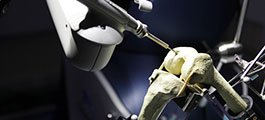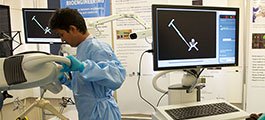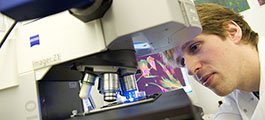Rehabilitation engineering is the application of scientific and engineering principles to research which is related to the musculo-skeletal system - the human body.
Within rehabilitation engineering, there are four main areas of research:
- Rehabilitation Technology
- Biomechanics
- Prosthetics & Orthotics
- Motor Control and Neuroprosthetics
Stroke Rehabilitation Technology Centre
Find out more about the work taking place in our Stroke Rehabilitation Technology Centre in the video below:
Biomechanics
Key members of staff - Professor Philip Rowe, Dr Philip Riches, Dr Andrew Kerr, Dr Craig Childs
Advanced 3D biomechanical models of joint function
Our strengths exist in the development of advanced 3D biomechanical models of joint function that incorporate MRI and mechanical testing of human tissue. We work together with the National Golden Jubilee Hospital and funding has been secured to further develop wrist biomechanics related to Computer Navigated Surgery. Work is underway in the areas of occupational health and carpal tunnel syndrome.
Joint replacement
We currently have projects with Glasgow Royal Infirmary to determine patient performance/function with joint replacements. Our research is supported by Stryker UK through a studentship and a research manager/facilitator who coordinates research activities of orthopaedic staff with the rehabilitation engineering group.
Key work in this area stems from an EPSRC study using telemetry to measure the loadings on replacement hip joints during everyday activities. This seminal study was carried out with the Free University of Berlin. Further work in this areas includes the functional outcome of computer navigated knee replacement and the development of clinical movement analysis systems.
Everyday tasks
Our biomechanics research also includes projects aimed at understanding how people do everyday tasks. This work ranges from activity monitoring to multidisciplinary projects on ageing and inclusive design.
EPSRC (EQUAL) funding has led to a unique way of incorporating complex joint loading data into computer animations allowing designers to assess the suitability of products for use by older people. The project involved collaboration with:
- The Glasgow School of Art
- Psychology (University of Strathclyde)
- The Health Faculty, Queen Margaret College University, Edinburgh
Development of this work will proceed through a New Dynamics of Ageing award led by Glasgow School of Art and a capacity building award (SPARC) investigating loadings in packaging for use by older people. Research examining environmental influences on mobility in older people has also taken place and will continue.
Mathematical models of intervertebral discs have been developed. They inform on normal disc functioning and its transfer to aged and diseased conditions. Work demonstrating the importance of strain dependency on the disc's permeability and of osmosis for disc nutrition led to an EPSRC award that allows a better understanding of the links between disc biomechanics and low back pain.
Prosthetics & Orthotics
Members of staff - Dr Arjan Buis, Mr Stephanos Solomonidis
The group undertakes research programmes investigating:
- biomechanical function
- design and manufacturing aspects
- clinical and laboratory evaluation of prosthetic, orthotic and wheelchair/seating systems
Our research uses various methodologies such as finite element analysis, MRI, interface pressure measurement and 3D ultrasound. Measurement needs in this field often require the construction of specialised transducers. The work is frequently undertaken with partners from industry (e.g. C.A. Blatchford and Sons, Basingstoke), other organisations (e.g. Kelvin Institute, Glasgow) and the NHS.
Motor Control & Neuroprosthetics
Our research is focused on gaining an improved understanding of the control processes that support mobility and motion in healthy subjects and those with additional support needs. This understanding allows us to investigate and develop technologies for rehabilitation and assistive devices to improve the quality of life of individuals with motor impairment. This work includes studies on people with conditions such as spinal cord injury and those without.
Currently, there are no cures for many of the neurological conditions that are caused by trauma or degeneration of the nervous system. Our research approach to these problems can be posed through the following questions:
- How can fundamental physiological knowledge, engineering and technology be applied to improve the quality of life and independence of disabled people?
- How can our research assist in translating promising laboratory based developments into practical everyday solutions for disabled people?
Motor function
A major focus of our work is to develop engineering solutions that have the potential to restore motor function for disabled people. In parallel, we're also engaged in the development of methods for improving the diagnosis and assessment of neurological injury which can be used to chart the natural recovery process. This work is based on fundamental physiological investigations, clinical studies, and the pursuit of technology transfer into clinical practice and the home.
Plasticity and adaptability
Plasticity and adaptability within the central nervous system are often considered to be the basis of rehabilitation and it's important that restoration of function due to these processes can be identified and quantified. This would aid diagnostics, allow for optimised rehabilitation strategies and also provide a basis on which the effectiveness of novel treatments for CNS repair can be judged. This methodological gap requires developments in neurophysiological monitoring and functional imaging of motor and sensory systems. It's a significant part of our current research.
Assistive technology
Our research also explores advanced forms of assistive technology and includes the emerging technology of brain computer interfacing and the use of robotic assistive devices for mobility and rehabilitation training in spinal cord injured patients.
We believe that technological innovations are an important element of the research road map that can help in improving the life quality of the most seriously disabled people. The research we employ is highly multidisciplinary.
Our work is part of the Glasgow Research Partnership in Engineering (GRPE) where we work together with the following local bodies:
- Queen Elizabeth National Spinal Injuries Unit, Southern General Hospital, Glasgow
- Centre for Rehabilitation Engineering, University of Glasgow
- The School of Health and Social Care, Glasgow Caledonian University
Our research is funded by Spinal Research, GRPE and The EPSRC Doctoral Training Centre in Medical Devices.
Our facilities
Our labs utilise state-of-the-art facilities for neurophysiological experimentation based on EEG, EMG and motion capture. We share access to research facilities at the Queen Elizabeth National Spinal Injuries Unit with the Centre for Rehabilitation Engineering, University of Glasgow.



